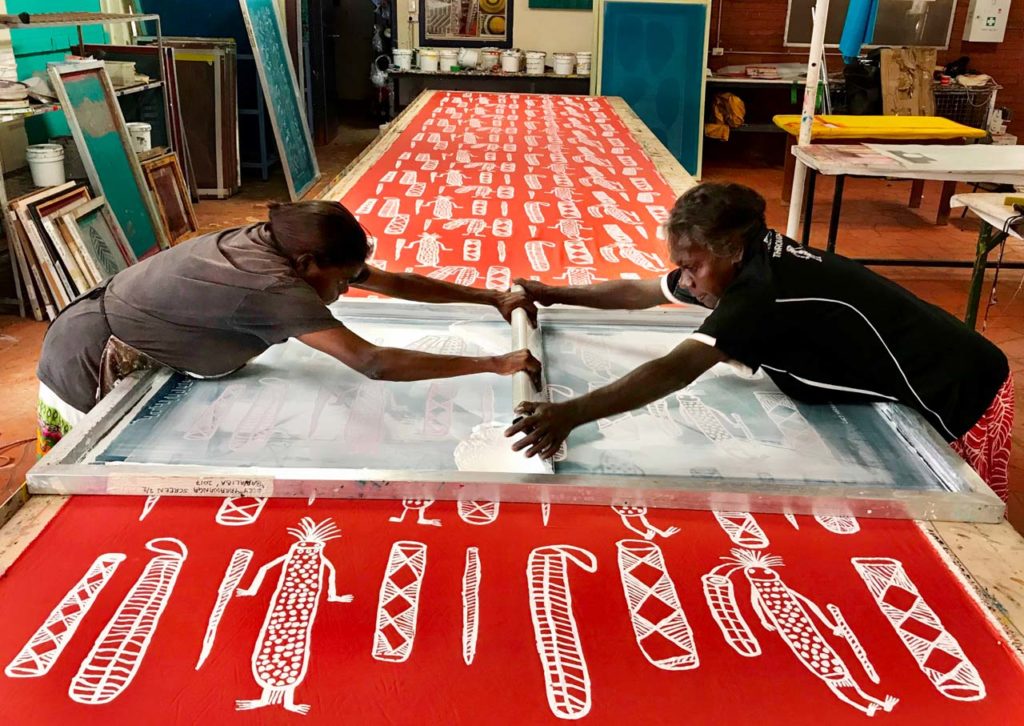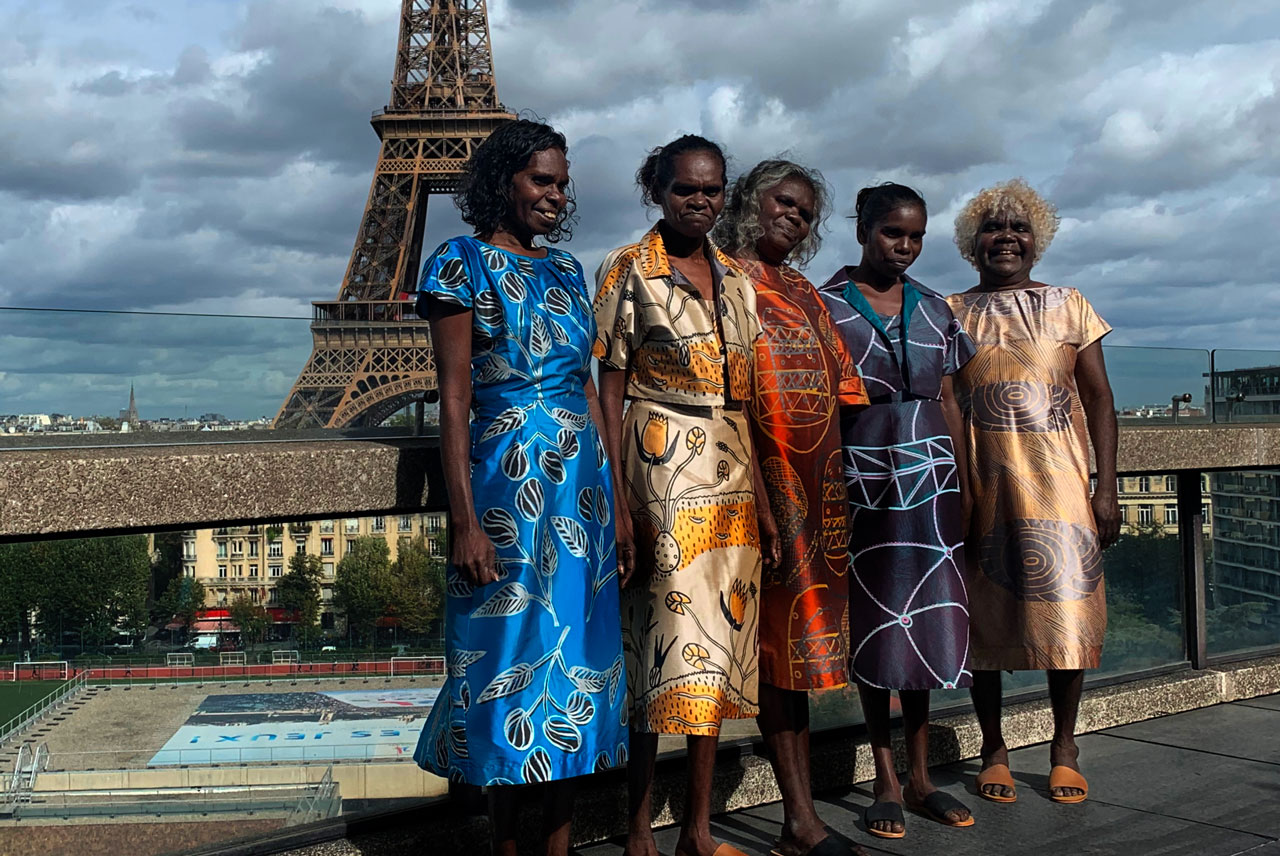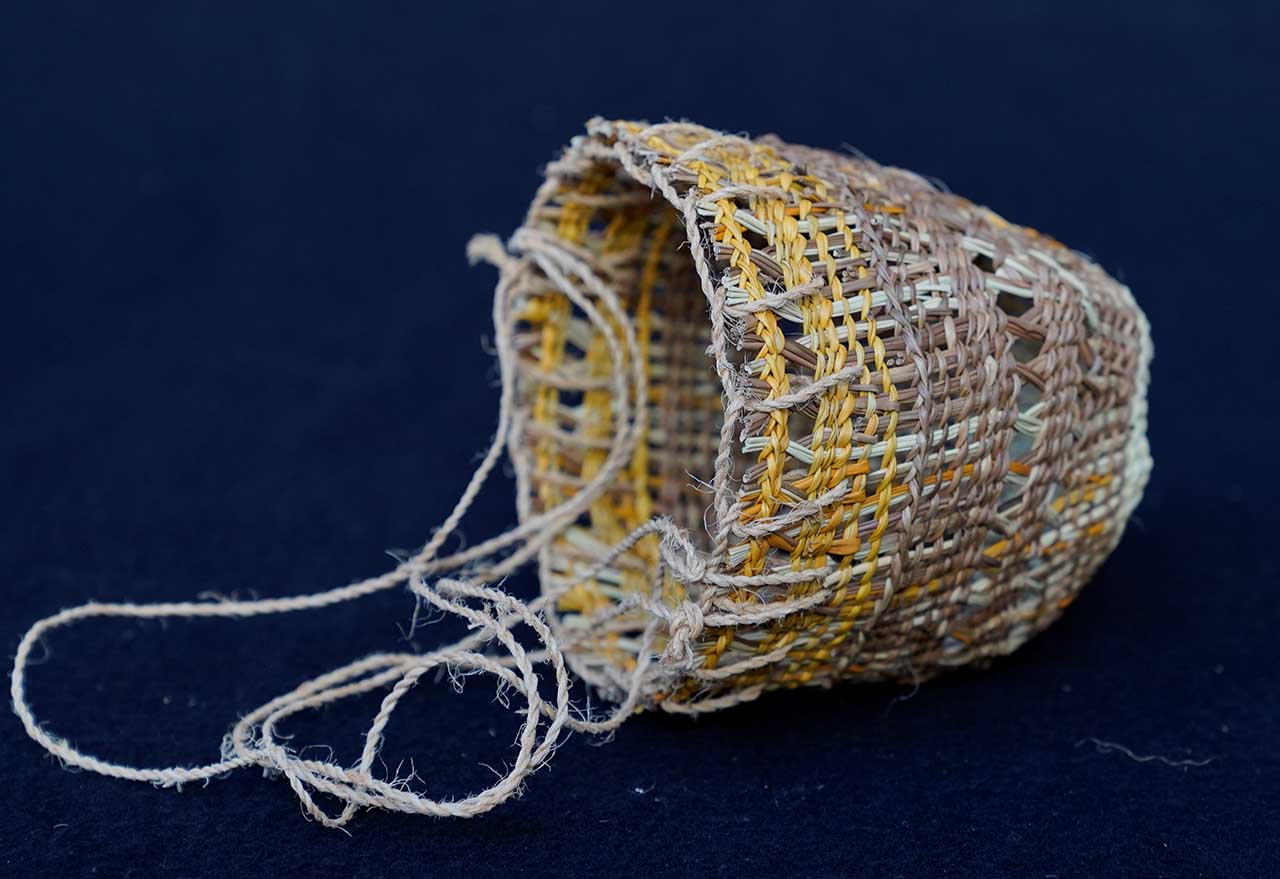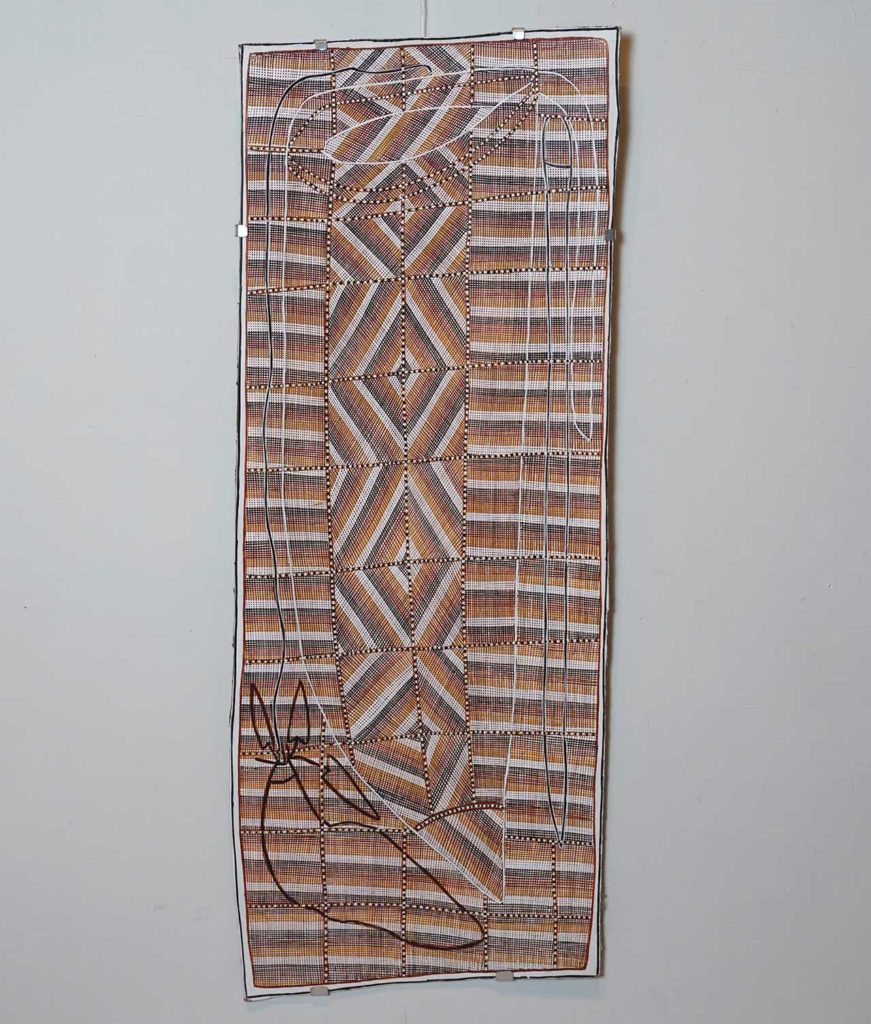Artists at Maningrida Art Centre
Ingrid Johanson is the former Manager of Bábbarra Women’s Centre in Maningrida in Arnhem Land. In this interview, Ingrid discusses the centre, the artists, the designs and a recent trip by the artists for an exhibition in Paris. A new exhibtion of works from Bábbarra Women’s Centre and Maningrida Arts and Culture opens this July 2020 at Japingka Gallery.
The Centre
What is the role of the Women's Centre in the community there?
The Women's Centre has been here for nearly 40 years. It started out as a women's refuge and it has developed into a place for women's economic and social activity. The purpose of the Women's Centre is to support local women to come together and to express themselves creatively. Women do that by depicting stories of culture and country through design, in particular textile design. We also run a few other enterprises including a community op shop, a laundromat and support homelands Women’s Centres. Everything comes back to supporting what women in remote Maningrida want to do. The focus is about the economic income, training and development for women specifically in Maningrida, and we are part of Bawinanga Aboriginal Corporation, a homelands resource organisation which has supported Maningrida community for more than forty years.
The Artists
How many artists are working there?
There are around 25 artists. It depends on the day, sometimes we only have a few artists come in. Sometimes we have 15, but we've got 25 artists on our books.
What motivates the artists? What gives them the most joy?
The artists love telling their cultural stories and they feel really proud of the responses to their textiles. We travelled to France last year as part of an exhibition, Jarracharra. There was an overwhelming response. People adore their textiles.
In France, people were impressed by the talent of the women and the depth of cultural knowledge that goes into their stories and into their designs. The women love seeing people wearing their designs and showing their work off to the world because it's not only just celebrating their artwork, it's really celebrating Aboriginal cultures, languages and history. It's empowering for the women and I think they all get a lot of joy seeing how much the outside world loves their work.
The Designs
How many textile designs would have been created there?
There's about 70 designs that we've made. Some of those are one screen, two screen, three screen or four screen, and just in one design. There are also hundreds of lino prints that have been made over decades.
The Paris Exhibition
How did the French exhibition come about?
I pitched the idea to the Australian Embassy in France in 2018, I said, "The International Year of Indigenous Language is coming up. Maningrida is one of the most linguistically diverse places in the world per capita.”
There's a wonderful exhibition space in the Australian Embassy. I proposed that the textiles would be really well suited for that space. I was also in France at the time, so I could take photos of the women, photos of our space and really share the story. Immediately the Australian Embassy was excited by it. The key challenge was the cost to get seven of us over there.
In the end, we secured two grants as well as crowdfunding. The crowdfunding campaign raised over $30,000 for us to get passports for all the ladies, and the trip allowed us to be part of Paris Fashion Week. We had our exhibition at the Australian Embassy, then we also had the popup shop in a really groovy district in Paris. We also did some really great tourism around Paris as well as parts of France as well. We visited the rock art in the South and fashion parade part of Paris Fashion Week and Normandy in the North.
Vogue magazine knew we were going over there. They got in touch and said, "We'd love to take a photo of the women wearing designs from their community," and put it in the 40th anniversary issue of Vogue, which they did.
The Passport Challenge
What in the whole experience took you by surprise?
It took me by surprise just how incredibly difficult it is for people in Maningrida, to access things that non-indigenous Australians often find very straightforward. So for example, the passports were an absolute nightmare to access. It took over two years of us really fighting to be able to get our passports, because people didn't necessarily have the right documentation. They might not have ever had a birth certificate. There are no street names in Maningrida. That meant that bureaucratically people didn't exist, or different identities existed. That was really shocking to think the first peoples of our nation have such a struggle to be able to access basic things that most Australians would just take for granted.
A Positive Reception
I was also pleasantly thrilled by the response the ladies got in Paris. People were just so respectful and inclusive. There were so many open and generous people. These included fashion designers, dignitaries, diplomats working for the UN or working for fashion labels. They all were just so humbled to meet the women. I think everyone in Europe really understood that it was such a significant thing for people to be travelling all the way from Maningrida.
The exhibition was such a success that they invited the exhibition to go to the European Parliament in Belgium. It was going to go to Berlin, Madrid, Athens and then be part of New York Textile Week. Then came coronavirus. Everything's a little bit on hold now.
A Personal Highlight
In the whole of that project, what was a highlight for you?
I think driving out of Maningrida. We all bundled in our troop carrier, which is kind of big, tough bush car with long seats out the back. We threw all of our luggage in there, seven women and two film crew- everyone was extremely cramped, but so full of good spirits. It was so lovely to see the joy of the women driving out of Maningrida along this dusty road. They were yelling out the window, "We're going to Paris. See you later Maningrida, we're off to Paris!" It was just so joyous to think people were so proud and excited to be going on this big adventure. I've been privileged enough to have travelled a lot before - I've seen a lot of places and always got a lot of pleasure out of travel, so to be able to experience that with women who haven't had that opportunity to go overseas before was really special.
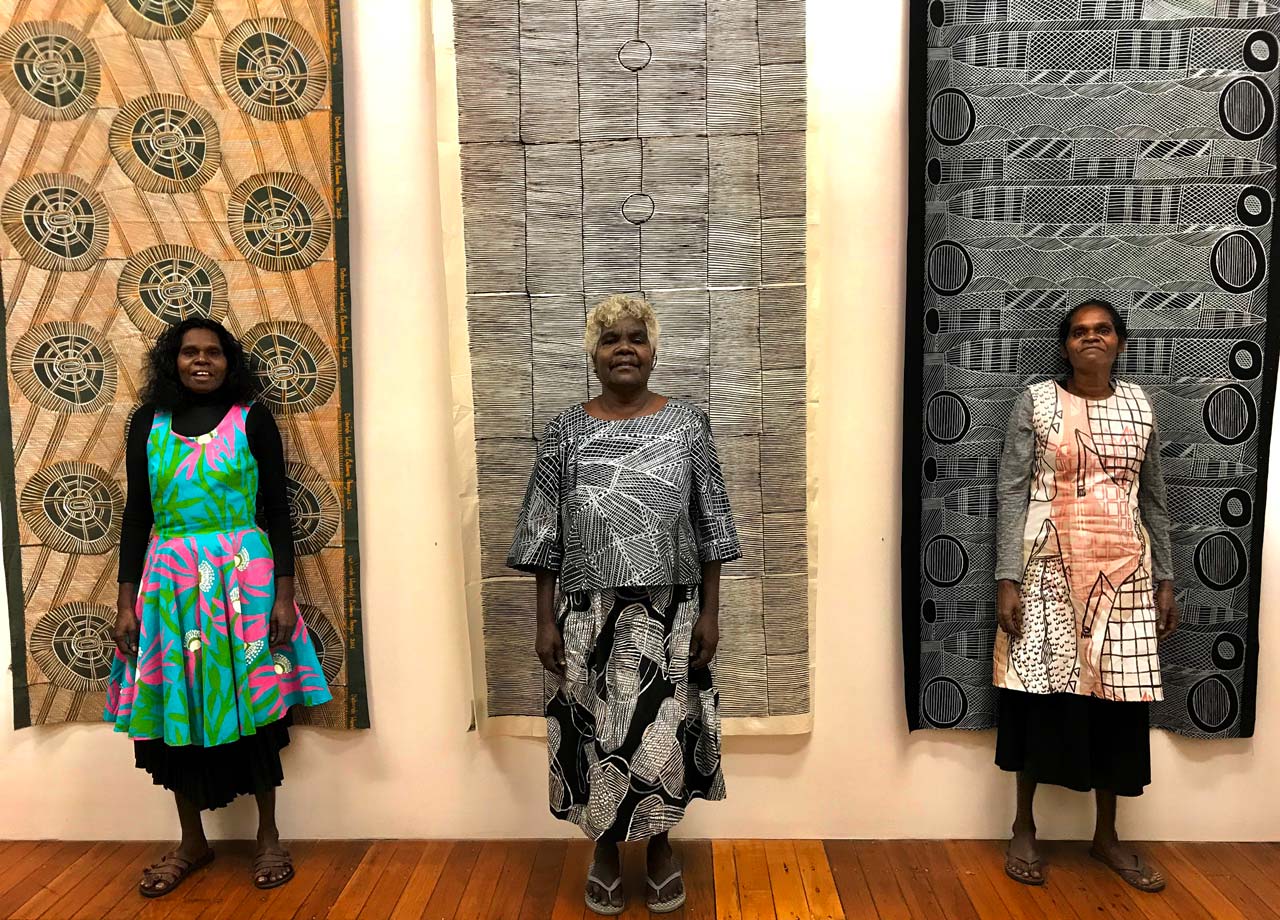
Jennifer Wurrkidj, Deborah Wurrkidj, Janet Marawarr - Karrang Kunred Exhibition, Sydney 2017 - photo by Ingrid Johanson
A Boom In Aboriginal Textile Design
Do you think there is a creative boom going on in textile design in Aboriginal communities generally?
Absolutely. There definitely is. In the last 10 years, I think particularly it's seen a real boom in indigenous artists working in textiles. People talk about the global financial crisis having an impact on this, as customers still wanted to purchase Aboriginal art during challenging financial times, and the price point is a lot more accessible for textiles when compared to larger canvas based or bark works. Indigenous fabrics are quite an affordable way to have incredible artwork in your house, in your life.
If you go to the Darwin Aboriginal Art Fair, you'll see the enormous amount of textiles available. Lots of different artist centres, who traditionally haven't worked with textiles, are now seeing it as an opportunity to diversify what they are producing. We've had a lot of interest from fashion designers and interior designers who would like to use our textiles. I think we’ll continue to see that grow and be more present in Australian architecture and fashion in the next few years.
The Role of Manager
How do you describe the manager’s role there at the Women's Centre?
I see it as a key role in enabling the women to be able to achieve what they want to achieve. The artists don't need any support in creating, they are experts in art and design. Where I have been able to provide support is making the studio and workshops happen, engaging with different galleries for exhibitions, commercial opportunities, training and development opportunities- I guess supporting the social enterprise to develop and be sustainable.
The manager looks after the operations of the Women's Centre, and ensures that the documentation is strong. I have done a lot of cultural documentation around the artwork story, visiting on country to see the sites, photography, filmmaking, to ensure all the stories are told how the artists want them to be told. It’s important not only for the artworks now, but it records invaluable cultural and linguistic knowledge which keeps culture strong, and can be passed down to the next generations- the women see this as extremely important. I see part of the manager’s role as being responsible for ensuring the women's work is celebrated and recognised on the level that it needs to be.
The artists really drive the Women’s Centre, which also acts as a space for the key concerns for women in the community. It's a bit of a multifaceted place. So even though we're predominantly focused on textile design, we also are the voice for women in Maningrida. It's a real hub for women to come and learn and engage and also discuss any issues, and advocate for women.
The Power of Social Media
What process is looking like the most effective way to bring the textiles to people's attention?
I think the work is so strong it really speaks for itself. We've done a really big push on social media, which has been well received. I think when I arrived here four years ago, there was quite a small social media presence. We've really worked on that, myself and my colleague Jess. This work has enabled people to learn more about women’s lives out here and the context behind the designs. The social media has absolutely blossomed and helped heaps of things for us to happen. We've got lots of different exhibition opportunities through social media. We've got news articles, exhibitions, and we've got many different projects happening though opening up communications.
The op shop is one hundred percent managed through donations which arrive through social media. For example, scabies is one of the issues, the health issues in community. And one of the key things preventing scabies is having clean sheets and clean towels. So Jess and I said, great. We can help with that. So we'll put on Facebook, donate your second hand towels. Donate your sheets for the Maningrida op shop. And within a few days, the post office is completely overwhelmed with parcels for Bábbarra Women’s Centre.
If you could make something happen up there, what do you would bring the most benefit to the Women's Centre?
More Senior Roles for Aboriginal Women
I think one thing I've been really passionate about is ensuring that there's local training and development of Aboriginal women here to step up into a higher roles.
We received a grant from Tim Fairfax Family Foundation for a mentoring position for a woman from Maningrida, and it was one of the highlights of my role to work closely with an incredibly skilled Burarra woman, Jess. I think ensuring that Aboriginal people like Jess are enabled to step up and take the reign in their own community is a really important thing. It would be a big change for the future if a lot of Aboriginal art centres could have Aboriginal people running them. Just recently Jess has taken over the manager’s role which is the first time the centre will have been managed by a local woman.
New Building
The other thing I would say that we're working towards is to get a new building. We've got quite an old building that we operate out of. It's really not very well designed for what we do, and the toilets are broken every second day, and the roof leaks in wet season and it’s boiling hot in the humid season. And so, we know these textiles are worth protecting and promoting and giving the right capacity to, and so we've been working hard to look at hopefully building a new Women's Centre in Maningrida soon with appropriate printing facilities, and appropriate space for women to work out of. So that's the kind of a longer term project that we're chipping away at.
Authentic Cultural Design
I think one thing that's very interesting for people to understand about the work is that while it is a contemporary medium, textile screen printing, the designs are from people who have lived and breathed these stories and the cultural motifs for many, many, many thousands of years up here. Arnhem Land has the oldest rock art in the entire world. It's been dated around 65,000 years old. The stories that you see on the textiles, even though they look contemporary, modern, colourful and bright, are actually ancient cultural narratives.
Ownership of Design
There is a very strict social organisation that not anybody can depict anything in their design. There are very strict rules and cultural protocols about who is allowed to paint which design or which cultural motif. So there's a lot of work people do to ensure the traditional land owners and the traditional caretakers of different motifs, stories and designs are properly consulted about their artworks, and correct protocols have been followed before the design appears in textiles. This is a really important part of the design process.
Rich Language
There is rich language that's associated with all the different narratives and artworks. People have really strong knowledge and cultural connections up here. Maningrida was never a colonial mission as such, and so people were not necessarily prevented from speaking their languages, and at the Women’s Centre we try to pepper our cultural documentation with as many terms in the artist’s language as we can. This is always the instruction from the senior women here and the Babbarra Women’s Governance Group.
Very often English just doesn't have an appropriate translation, so we use the term in the artist's language, with the best English translation we can provide- for example yawkyawk (Kuninjku language) cannot be translated simply, as it refers to a concept non-Indigenous Australians do not have. Yawkyawk are sacred female water mermaid spirits, who live in fresh water streams in the Arnhem Land rock country. Even the title of this show ‘Kunmadj’ (Kuninjku language) has deeper meaning than woven objects, or dilly bags- something closer to material culture, but it can also be used for fabric, bedding, clothing, so it is key that we continue to use the terms in local languages, to keep the languages alive and continue to teach people through our artworks about the sophistication and complexity of Indigenous cultures and languages.
The women are very aware of the need to preserve their stories. There is a lot of thought about how an elderly artist might pass on important cultural knowledge to the future generations. People still live a very culturally rich life everyday up here, which makes Maningrida such an exciting place.
The Dilly Bag Exhibition at Japingka
The exhibition, Kunmadj, was the idea from Bábbarra Women’s Centre and Maningrida Arts and Culture. Dilly bags are one of the key motifs that women continue to weave or print on textiles. Dilly bags are the traditional woven vessels that people have used for thousands of years, woven from pandanus or sedge grass. They’ve always been used by men and women to carry bush food, fresh fish or to carry sacred objects at ceremony time. For many years, we've been joking about the idea, "One day, we're going to do a Kunmadj exhibition, just celebrating dilly bags", so now everyone's happy that we finally got to that point and we're doing this exhibition.
It's great to work with the Maningrida Arts Centre, who have provided the real woven objects that are depicted by women through the textiles. The idea is that people can really experience the design elements of a dilly bag printed on the textiles, and then actually see the objects in real life.
Culture here is still really strong and many women know how to weave dilly bags. They also weave baskets and mats from all natural fibres. They go out and collect and harvest all the natural materials themselves. We're all very excited about the Kunmadj exhibition.
Bark Paintings
There are some very delicate little bark paintings from Yirrkala. They come from the Buku-Larrnggay community. These wonderfully painted barks, some of them just maybe 40 centimetres tall, are quite compact and beautifully painted in ochre. The artists are using traditional designs and painting elements of bush food from that area of coastal Northern Territory.
The barks are gorgeous and they're here along with a group of bird carvings; again, carved from local timber and painted in ochre. They are representing the natural world, the bird life, the plants, aspects of water and fire. We are delighted to include these beautiful little works from Yirrkala in this exhibition.
View: Kunmadj Woven Objects Exhibition

